Cold-Start Energy Consumption and CO2 Emissions—A Comparative Assessment of Various Powertrains in the Context of Short-Distance Trips
Abstract
1. Introduction
2. Materials and Methods
3. Results
3.1. Energy Consumption
3.1.1. Impact of Cold Start on Energy Consumption
3.1.2. Impact of Distance on Energy Consumption
3.2. CO2 Emissions
3.2.1. Impact of Cold Start on CO2 Emissions
3.2.2. Impact of Distance on CO2 Emissions
4. Discussion
5. Conclusions
Author Contributions
Funding
Data Availability Statement
Acknowledgments
Conflicts of Interest
Appendix A
| Country | Indirect CO2 Emission [g/km] | |||
|---|---|---|---|---|
| Distance = 3 km | Distance = 5 km | Distance = 10 km | Distance = 12 km | |
| Belgium | 74.3 | 63.1 | 60.4 | 60.9 |
| Bulgaria | 222.4 | 188.9 | 180.9 | 182.4 |
| Czechia | 239.3 | 203.3 | 194.7 | 196.3 |
| Denmark | 45.4 | 38.6 | 36.9 | 37.3 |
| Germany | 168.0 | 142.6 | 136.6 | 137.8 |
| Estonia | 109.6 | 93.1 | 89.2 | 89.9 |
| Ireland | 152.7 | 129.7 | 124.2 | 125.3 |
| Greece | 181.0 | 153.7 | 147.2 | 148.4 |
| Spain | 76.7 | 65.2 | 62.4 | 62.9 |
| France | 29.9 | 25.4 | 24.3 | 24.5 |
| Croatia | 165.5 | 140.5 | 134.6 | 135.7 |
| Italy | 124.9 | 106.1 | 101.6 | 102.5 |
| Cyprus | 290.6 | 246.8 | 236.4 | 238.4 |
| Latvia | 132.6 | 112.6 | 107.8 | 108.7 |
| Lithuania | 34.2 | 29.0 | 27.8 | 28.0 |
| Luxembourg | 125.4 | 106.5 | 102.0 | 102.9 |
| Hungary | 97.0 | 82.4 | 78.9 | 79.6 |
| Malta | 156.5 | 132.9 | 127.3 | 128.4 |
| Netherlands | 144.7 | 122.9 | 117.7 | 118.7 |
| Austria | 106.8 | 90.7 | 86.9 | 87.6 |
| Poland | 341.6 | 290.1 | 277.9 | 280.2 |
| Portugal | 78.8 | 66.9 | 64.1 | 64.6 |
| Romania | 166.0 | 141.0 | 135.0 | 136.2 |
| Slovenia | 89.5 | 76.0 | 72.8 | 73.4 |
| Slovakia | 155.0 | 131.6 | 126.1 | 127.1 |
| Finland | 25.1 | 21.4 | 20.5 | 20.6 |
| Sweden | 6.2 | 5.3 | 5.1 | 5.1 |
| Iceland | 0.1 | 0.1 | 0.1 | 0.1 |
| Norway | 5.2 | 4.4 | 4.2 | 4.3 |
| Country | Indirect CO2 Emission [g/km] | |||
|---|---|---|---|---|
| Distance = 3 km | Distance = 5 km | Distance = 10 km | Distance = 12 km | |
| Belgium | 38.2 | 30.1 | 26.2 | 25.5 |
| Bulgaria | 114.5 | 90.0 | 78.6 | 76.4 |
| Czechia | 123.2 | 96.9 | 84.6 | 82.2 |
| Denmark | 23.4 | 18.4 | 16.1 | 15.6 |
| Germany | 86.4 | 68.0 | 59.4 | 57.7 |
| Estonia | 56.4 | 44.4 | 38.7 | 37.6 |
| Ireland | 78.6 | 61.8 | 54.0 | 52.4 |
| Greece | 93.1 | 73.2 | 64.0 | 62.1 |
| Spain | 39.5 | 31.1 | 27.1 | 26.3 |
| France | 15.4 | 12.1 | 10.5 | 10.3 |
| Croatia | 85.2 | 67.0 | 58.5 | 56.8 |
| Italy | 64.3 | 50.6 | 44.1 | 42.9 |
| Cyprus | 149.5 | 117.6 | 102.7 | 99.8 |
| Latvia | 68.2 | 53.7 | 46.9 | 45.5 |
| Lithuania | 17.6 | 13.8 | 12.1 | 11.7 |
| Luxembourg | 64.5 | 50.8 | 44.3 | 43.1 |
| Hungary | 49.9 | 39.3 | 34.3 | 33.3 |
| Malta | 80.5 | 63.4 | 55.3 | 53.7 |
| Netherlands | 74.4 | 58.6 | 51.1 | 49.7 |
| Austria | 54.9 | 43.2 | 37.7 | 36.7 |
| Poland | 175.8 | 138.3 | 120.7 | 117.3 |
| Portugal | 40.6 | 31.9 | 27.9 | 27.1 |
| Romania | 85.4 | 67.2 | 58.7 | 57.0 |
| Slovenia | 46.1 | 36.2 | 31.6 | 30.7 |
| Slovakia | 79.7 | 62.7 | 54.8 | 53.2 |
| Finland | 12.9 | 10.2 | 8.9 | 8.6 |
| Sweden | 3.2 | 2.5 | 2.2 | 2.1 |
| Iceland | 0.0 | 0.0 | 0.0 | 0.0 |
| Norway | 2.7 | 2.1 | 1.8 | 1.8 |
| Country | Indirect CO2 Emission [g/km] | |||
|---|---|---|---|---|
| Distance = 3 km | Distance = 5 km | Distance = 10 km | Distance = 12 km | |
| Belgium | 47.8 | 37.4 | 32.7 | 32.3 |
| Bulgaria | 143.0 | 111.9 | 97.8 | 96.8 |
| Czechia | 153.9 | 120.4 | 105.3 | 104.1 |
| Denmark | 29.2 | 22.8 | 20.0 | 19.8 |
| Germany | 108.0 | 84.5 | 73.9 | 73.1 |
| Estonia | 70.5 | 55.1 | 48.2 | 47.7 |
| Ireland | 98.2 | 76.8 | 67.2 | 66.5 |
| Greece | 116.4 | 91.0 | 79.6 | 78.7 |
| Spain | 49.3 | 38.6 | 33.7 | 33.4 |
| France | 19.2 | 15.0 | 13.1 | 13.0 |
| Croatia | 106.4 | 83.2 | 72.8 | 72.0 |
| Italy | 80.3 | 62.8 | 54.9 | 54.4 |
| Cyprus | 186.9 | 146.2 | 127.8 | 126.4 |
| Latvia | 85.3 | 66.7 | 58.3 | 57.7 |
| Lithuania | 22.0 | 17.2 | 15.0 | 14.9 |
| Luxembourg | 80.7 | 63.1 | 55.2 | 54.6 |
| Hungary | 62.4 | 48.8 | 42.7 | 42.2 |
| Malta | 100.7 | 78.7 | 68.8 | 68.1 |
| Netherlands | 93.0 | 72.8 | 63.6 | 62.9 |
| Austria | 68.7 | 53.7 | 47.0 | 46.5 |
| Poland | 219.7 | 171.8 | 150.3 | 148.7 |
| Portugal | 50.7 | 39.6 | 34.7 | 34.3 |
| Romania | 106.8 | 83.5 | 73.0 | 72.2 |
| Slovenia | 57.6 | 45.0 | 39.4 | 39.0 |
| Slovakia | 99.7 | 77.9 | 68.2 | 67.4 |
| Finland | 16.2 | 12.6 | 11.1 | 10.9 |
| Sweden | 4.0 | 3.1 | 2.7 | 2.7 |
| Iceland | 0.0 | 0.0 | 0.0 | 0.0 |
| Norway | 3.3 | 2.6 | 2.3 | 2.3 |
References
- Alhindawi, R.; Abu Nahleh, Y.; Kumar, A.; Shiwakoti, N. Projection of Greenhouse Gas Emissions for the Road Transport Sector Based on Multivariate Regression and the Double Exponential Smoothing Model. Sustainability 2020, 12, 9152. [Google Scholar] [CrossRef]
- Albuquerque, F.D.; Maraqa, M.A.; Chowdhury, R.; Mauga, T.; Alzard, M. Greenhouse gas emissions associated with road transport projects: Current status, benchmarking, and assessment tools. Transp. Res. Procedia 2020, 48, 2018–2030. [Google Scholar] [CrossRef]
- Ali, M.; Macioszek, E.; Onyelowe, K.; Yuen, C.W.; Arif, K. Interaction of activity travel, GHG emissions, and health parameters using R—A Step towards sustainable transportation system. Ain Shams Eng. J. 2024, 15, 103050. [Google Scholar] [CrossRef]
- Li, Y.; Ha, N.; Li, T. Research on Carbon Emissions of Electric Vehicles throughout the Life Cycle Assessment Taking into Vehicle Weight and Grid Mix Composition. Energies 2019, 12, 3612. [Google Scholar] [CrossRef]
- Zhang, W.; Li, Y.; Li, H.; Liu, S.; Zhang, J.; Kong, Y. Systematic review of life cycle assessments on carbon emissions in the transportation system. Environ. Impact Assess. Rev. 2024, 109, 107618. [Google Scholar] [CrossRef]
- Lu, Y.; Liu, Q.; Li, B.; Jiang, Q.; Li, Q. Energy mix-driven dynamic life cycle assessment on greenhouse gas emissions of passenger cars in China. J. Clean. Prod. 2024, 466, 142817. [Google Scholar] [CrossRef]
- Kocsis, D.; Kiss, J.T.; Arpad, I.W. Evaluating battery electric vehicle usage in the EU: A comparative study based on member state energy mixes. Heliyon 2024, 10, e30655. [Google Scholar] [CrossRef]
- Joana, B.; Fabio, M.-F.; Giulia, M. GHG Emission Factors for Electricity Consumption. European Commission, Joint Research Centre (JRC) PID. 2024. Available online: http://data.europa.eu/89h/919df040-0252-4e4e-ad82-c054896e1641 (accessed on 21 May 2024).
- European Commission. CO2 Emission Performance Standards for Cars and Vans. 2021. Available online: https://climate.ec.europa.eu/eu-action/transport/road-transport-reducing-co2-emissions-vehicles/co2-emission-performance-standards-cars-and-vans_en (accessed on 21 January 2024).
- Dornoff, J. CO2 Emission Standards for New Passenger Cars and Vans in the European Union; International Council on Clean Transportation: Washington, DC, USA, 2023; Available online: https://theicct.org/wp-content/uploads/2023/05/eu-co2-standards-cars-vans-may23.pdf (accessed on 9 January 2024).
- Twum-Duah, N.K.; Neves Mosquini, L.H.; Shahid, M.S.; Osonuga, S.; Wurtz, F.; Delinchant, B. The Indirect Carbon Cost of E-Mobility for Select Countries Based on Grid Energy Mix Using Real-World Data. Sustainability 2024, 16, 5883. [Google Scholar] [CrossRef]
- Mofolasayo, A. Assessing and Managing the Direct and Indirect Emissions from Electric and Fossil-Powered Vehicles. Sustainability 2023, 15, 1138. [Google Scholar] [CrossRef]
- Burchart, D.; Przytuła, I. Carbon Footprint of Electric Vehicles—Review of Methodologies and Determinants. Energies 2024, 17, 5667. [Google Scholar] [CrossRef]
- Messagie, M. Life Cycle Analysis of the Climate Impact of Electric Vehicles; Transport & Environment: Brussels, Belgium, 2020; Available online: https://www.transportenvironment.org/uploads/files/TE20-20draft20report20v04.pdf (accessed on 9 September 2025).
- Sobol, Ł.; Dyjakon, A. The Influence of Power Sources for Charging the Batteries of Electric Cars on CO2 Emissions during Daily Driving: A Case Study from Poland. Energies 2020, 13, 4267. [Google Scholar] [CrossRef]
- Ahmed, A.A.; Nazzal, M.A.; Darras, B.M.; Deiab, I.M. A Comprehensive Sustainability Assessment of Battery Electric Vehicles, Fuel Cell Electric Vehicles, and Internal Combustion Engine Vehicles through a Comparative Circular Economy Assessment Approach. Sustainability 2023, 15, 171. [Google Scholar] [CrossRef]
- Ali, Q.; Di Silvestre, M.L.; Lombardi, P.A.; Riva Sanseverino, E.; Zizzo, G. Electrifying the Road to Net-Zero: Implications of Electric Vehicles and Carbon Emission Coefficient Factors in European Power Systems. Sustainability 2024, 16, 5084. [Google Scholar] [CrossRef]
- Athanasopoulou, L.; Bikas, H.; Stavropoulos, P. Comparative Well-to-Wheel Emissions Assessment of Internal Combustion Engine and Battery Electric Vehicles. Procedia CIRP 2018, 78, 25–30. [Google Scholar] [CrossRef]
- Negri, M.; Bieker, G. Life-Cycle Greenhouse Gas Emissions from Passenger Cars in the European Union: A 2025 Update and Key Factors to Consider; International Council on Clean Transportation: Washington, DC, USA, 2025; Available online: https://theicct.org/wp-content/uploads/2025/07/ID-392-–-Life-cycle-GHG_report_final.pdf (accessed on 9 September 2025).
- Franzò, S.; Nasca, A. The environmental impact of electric vehicles: A novel life cycle-based evaluation framework and its applications to multi-country scenarios. J. Clean. Prod. 2021, 315, 128005. [Google Scholar] [CrossRef]
- Qing, G.; Xiang, Y.; Shang, Y.; Liu, X.; Zhou, H.; Huang, Y. Carbon footprint evaluation for electric vehicles considering green electricity trading. Renew. Energy 2024, 237, 121510. [Google Scholar] [CrossRef]
- Guo, B.; Hou, J.; Sun, A.; Song, F.; Jiang, Z. Beyond the average: Emissions from electricity and the implications of decarbonization policies in Guangdong. J. Clean. Prod. 2024, 480, 143911. [Google Scholar] [CrossRef]
- Joshua, R.K.A.; Subramanian, K.A. Comparative performance and emission analysis of internal combustion engine and battery electric vehicle under modified Indian drive cycle. Process Saf. Environ. Prot. 2024, 190 Pt B, 211–220. [Google Scholar] [CrossRef]
- Marczak, H.; Droździel, P. Analysis of Pollutants Emission into the Air at the Stage of an Electric Vehicle Operation. J. Ecol. Eng. 2021, 22, 182–188. [Google Scholar] [CrossRef] [PubMed]
- Guo, J.; Xie, D.; Jiang, Y.; Li, Y. A novel construction and evaluation framework for driving cycle of electric vehicles based on energy consumption and emission analysis. Sustain. Cities Soc. 2024, 117, 105951. [Google Scholar] [CrossRef]
- Abramek, K.F.; Gołębiewski, W.; Osipowicz, T.; Lewicki, W.; Klyus, O. Green Transformation of Transport on The Example of Emission Assessment of Carbon Dioxide (CO2) Emissions in Electric and Combustion Engine Vehicles During Operation. Commun. Int. Proc. 2023, 2023, 4238723. [Google Scholar] [CrossRef]
- Challa, R.; Kamath, D.; Anctil, A. Well-to-wheel greenhouse gas emissions of electric versus combustion vehicles from 2018 to 2030 in the US. J. Environ. Manag. 2022, 308, 114592. [Google Scholar] [CrossRef]
- Feng, Y.; Yang, J.; Dong, Z. Fuel Selections for Electrified Vehicles: A Well-to-Wheel Analysis. World Electr. Veh. J. 2021, 12, 151. [Google Scholar] [CrossRef]
- Ramírez-Díaz, A.J.; Ramos-Real, F.J.; Barrera-Santana, J. Well-to-Wheels for Light-Duty Vehicle Powertrains by Segments in Isolated Systems. Energies 2023, 16, 1018. [Google Scholar] [CrossRef]
- Qian, S.; Li, L. A Comparison of Well-to-Wheels Energy Use and Emissions of Hydrogen Fuel Cell, Electric, LNG, and Diesel-Powered Logistics Vehicles in China. Energies 2023, 16, 5101. [Google Scholar] [CrossRef]
- Kuyumcu, A.M.; Bingül, B.; Akar, F.; Yıldız, A. Well-to-wheel carbon footprint and cost analysis of gasoline, diesel, hydrogen ICE, hybrid and fully electric city buses. Energy 2024, 301, 131685. [Google Scholar] [CrossRef]
- Fandi, G.; Novák, J.; Chyský, J.; Šrom, J. Review and modeling on hydrogen fuel cells electric vehicle (HFCEV), in comparison with battery electrical vehicle (BEV) using MATLAB environment. Case study: Postal car. Energy Convers. Manag. X 2024, 24, 100684. [Google Scholar] [CrossRef]
- Xu, F.; Crawford, C.; Feng, Y.; Lin, Z.; Li, S. Environment-economic analysis of diesel, hybrid electric, plug-in hybrid electric trucks in China. Transp. Res. Part D: Transp. Environ. 2023, 117, 103661. [Google Scholar] [CrossRef]
- Dong, Y.; Guo, X.; Wang, M.; Xu, J. Modeling carbon intensity of electric vehicles in the well-to-wheels phase under different traffic flow conditions. iScience 2024, 27, 111070. [Google Scholar] [CrossRef] [PubMed]
- Jaworski, A.; Mądziel, M.; Lew, K.; Campisi, T.; Woś, P.; Kuszewski, H.; Wojewoda, P.; Ustrzycki, A.; Balawender, K.; Jakubowski, M. Evaluation of the Effect of Chassis Dynamometer Load Setting on CO2 Emissions and Energy Demand of a Full Hybrid Vehicle. Energies 2022, 15, 122. [Google Scholar] [CrossRef]
- Joint Research Centre; Pasaoglu, G.; Fiorello, D.; Martino, A.; Scarcella, G.; Alemanno, A.; Zubaryeva, A.; Thiel, C. Driving and Parking Patterns of European Car Drivers—A Mobility Survey; JRC Publications: Ispra, Italy, 2012; Available online: https://www.google.com/url?sa=t&source=web&rct=j&opi=89978449&url=https://publications.jrc.ec.europa.eu/repository/bitstream/JRC77079/driving%2520and%2520parking%2520patterns%2520-%2520final_online.pdf&ved=2ahUKEwjR9NTGppSQAxVGX_EDHSlhNIEQFnoECC0QAQ&usg=AOvVaw1JpsGVV6nyaKUMpC5RFKt8 (accessed on 2 January 2024).
- Jaworski, A.; Kuszewski, H.; Ustrzycki, A.; Balawender, K.; Lejda, K.; Woś, P. Analysis of the repeatability of the exhaust pollutants emission research results for cold and hot starts under controlled driving cycle conditions. Environ. Sci. Pollut. Res. 2018, 25, 17862–17877. [Google Scholar] [CrossRef]
- Jaworski, A.; Mądziel, M.; Kuszewski, H.; Lejda, K.; Balawender, K.; Jaremcio, M.; Jakubowski, M.; Wojewoda, P.; Lew, K.; Ustrzycki, A. Analysis of Cold Start Emission from Light Duty Vehicles Fueled with Gasoline and LPG for Selected Ambient Temperatures; SAE Technical Paper 2020-01-2207; SAE International: Warrendale, PA, USA, 2020. [Google Scholar] [CrossRef]
- Pielecha, J.; Merkisz, J.; Kurtyka, K.; Skobiej, K. Cold start emissions of passenger cars with gasoline and diesel engines in Real Driving Emissions tests. Combust. Engines 2019, 179, 160–168. [Google Scholar] [CrossRef]
- Pielecha, J.; Skobiej, K.; Kurtyka, K. Testing and evaluation of cold-start emissions from a gasoline engine in RDE test at two different ambient temperatures. Open Eng. 2021, 11, 425–434. [Google Scholar] [CrossRef]
- Hu, J.; Frey, H.C.; Boroujeni, B.Y. Contribution of Cold Starts to Real-World Trip Emissions for Light-Duty Gasoline Vehicles. Atmosphere 2023, 14, 35. [Google Scholar] [CrossRef]
- Lijewski, P.; Kozak, M.; Fuć, P.; Rymaniak, Ł.; Ziółkowski, A. Exhaust emissions generated under actual operating conditions from a hybrid vehicle and an electric one fitted with a range extender. Transp. Res. Part D Transp. Environ. 2020, 78, 102183. [Google Scholar] [CrossRef]
- Bieniek, A.; Graba, M.; Mamala, J.; Prażnowski, K.; Hennek, K. Energy consumption of a passenger car with a hybrid powertrain in real traffic conditions. Combust. Engines 2022, 191, 15–22. [Google Scholar] [CrossRef]
- Skuza, A.; Szumska, E.M.; Jurecki, R.; Pawelec, A. Modeling the Impact of Traffic Parameters on Electric Vehicle Energy Consumption. Energies 2024, 17, 5423. [Google Scholar] [CrossRef]
- Jung, H.; Silva, R.; Han, M. Scaling Trends of Electric Vehicle Performance: Driving Range, Fuel Economy, Peak Power Output, and Temperature Effect. World Electr. Veh. J. 2018, 9, 46. [Google Scholar] [CrossRef]
- Parker, N.C.; Kuby, M.; Liu, J.; Stechel, E.B. Extreme heat effects on electric vehicle energy consumption and driving range. Appl. Energy 2025, 380, 125051. [Google Scholar] [CrossRef]
- Ansari, A.; Abediasl, H.; Shahbakhti, M. Ambient Temperature Effects on Energy Consumption and CO2 Emissions of a Plug-in Hybrid Electric Vehicle. Energies 2024, 17, 3566. [Google Scholar] [CrossRef]
- Graba, M.; Mamala, J.; Bieniek, A.; Augustynowicz, A.; Czernek, K.; Krupińska, A.; Włodarczak, S.; Ochowiak, M. Assessment of Energy Demand for PHEVs in Year-Round Operating Conditions. Energies 2023, 16, 5571. [Google Scholar] [CrossRef]
- Szumska, E.M.; Jurecki, R.S. Parameters Influencing on Electric Vehicle Range. Energies 2021, 14, 4821. [Google Scholar] [CrossRef]
- Seo, J.; Vijayagopal, R.; Kim, N.; Rousseau, A.; Stutenberg, K. Effects of ambient temperature on electric vehicle range considering battery Performance, powertrain Efficiency, and HVAC load. Energy Convers. Manag. 2023, 326, 119493. [Google Scholar] [CrossRef]
- Walsh, P.; Isaac, R.; Vijayagopal, R.; Rousseau, A.; Seo, J.; Kim, N. Impact of Cold Ambient Temperature and Extreme Conditions on Electric Vehicles. 2024. Available online: https://www.energy.gov/sites/default/files/2024-10/Impact_of_Cold_Ambient_Temperature_on_BEV_Performance_v15_TechEditFinal_12Sep2024__0.pdf (accessed on 7 September 2025).
- Bao, J.; Mao, Y.; Zhang, Y.; Xu, H.; Jiang, Y.; Yang, Y. Critical Review of Temperature Prediction for Lithium-Ion Batteries in Electric Vehicles. Batteries 2024, 10, 421. [Google Scholar] [CrossRef]
- Zhang, X.; Li, Z.; Luo, L.; Fan, Y.; Du, Z. A review on thermal management of lithium-ion batteries for electric vehicles. Energy 2022, 238, 121652. [Google Scholar] [CrossRef]
- Agronne National Laboratory. Available online: https://www.anl.gov/taps/downloadable-dynamometer-database (accessed on 2 January 2025).
- DieselNet. Emission Test Cycles. FTP-75. Available online: https://dieselnet.com/standards/cycles/ftp75.php (accessed on 7 January 2022).
- Stutenberg, K.; Lohse-Busch, H.; Duoba, M.; Iliev, S.; Jehlik, F.; Di Russo, M. An Overview of Argonne’s Advanced Mobility Technology Laboratory Vehicle Systems Instrumentation and Evaluation Methodology; Argonne National Laboratory: Lemont, IL, USA, 2021. [Google Scholar] [CrossRef]
- European Commission. Commission Report Under Article 12 of Regulation (EU) 2019/631 on the Evolution of the Real-World CO2 Emissions Gap for Passenger Cars and Light Commercial Vehicles and Containing the Anonymised and Aggregated Real-World Datasets Referred to in Article 12 of Commission Implementing Regulation (EU) 2021/392. Available online: https://climate.ec.europa.eu/document/download/b644dafe-1385-4b56-98d9-21e7e9f3601b_en?filename=report.pdf (accessed on 1 September 2025).
- Di Russo, M.; Stutenberg, K.; Hall, C.M. Analysis of Uncertainty Impacts on Emissions and Fuel Economy Evaluation for Chassis Dynamometer Testing. In IEEE Transactions on Vehicular Technology; IEEE: Piscataway, NJ, USA, 2023; Volume 72, pp. 4236–4251. [Google Scholar] [CrossRef]
- Adamiak, B.; Andrych-Zalewska, M.; Merkisz, J.; Chłopek, Z. The uniqueness of pollutant emission and fuel consumption test results for road vehicles tested on a chassis dynamometer. Eksploat. I Niezawodn. Maint. Reliab. 2025, 27, 195747. [Google Scholar] [CrossRef]
- European Union. UN Regulation No 154—Uniform Provisions Concerning the Approval of Light Duty Passenger and Commercial Vehicles with Regards to Criteria Emissions, Emissions of Carbon Dioxide and Fuel Consumption and/or the Measurement of Electric Energy Consumption and Electric Range (WLTP) [2022/2124]. Available online: https://op.europa.eu/en/publication-detail/-/publication/ec09c0bb-609c-11ed-92ed-01aa75ed71a1 (accessed on 1 September 2025).
- Juhrich, K. CO2 Emission Factors for Fossil Fuels; German Environment Agency: Dessau-Rosslau, Germany, 2016; Available online: https://www.umweltbundesamt.de/sites/default/files/medien/1968/publikationen/co2_emission_factors_for_fossil_fuels_correction.pdf (accessed on 10 September 2025).
- Krajowy Ośrodek Bilansowania i Zarządzania Emisjami (KOBiZE). Emission Factors for CO2, SO2, NOx, CO, and Total Particulate Matter for Electricity Based on Information Contained in the National Database on Greenhouse Gas and Other Substance Emissions for the Year 2022. 2023. Available online: https://www.kobize.pl/uploads/materialy/materialy_do_pobrania/wskazniki_emisyjnosci/Wskazniki_emisyjnosci_2022.pdf (accessed on 21 May 2025). (In Polish).
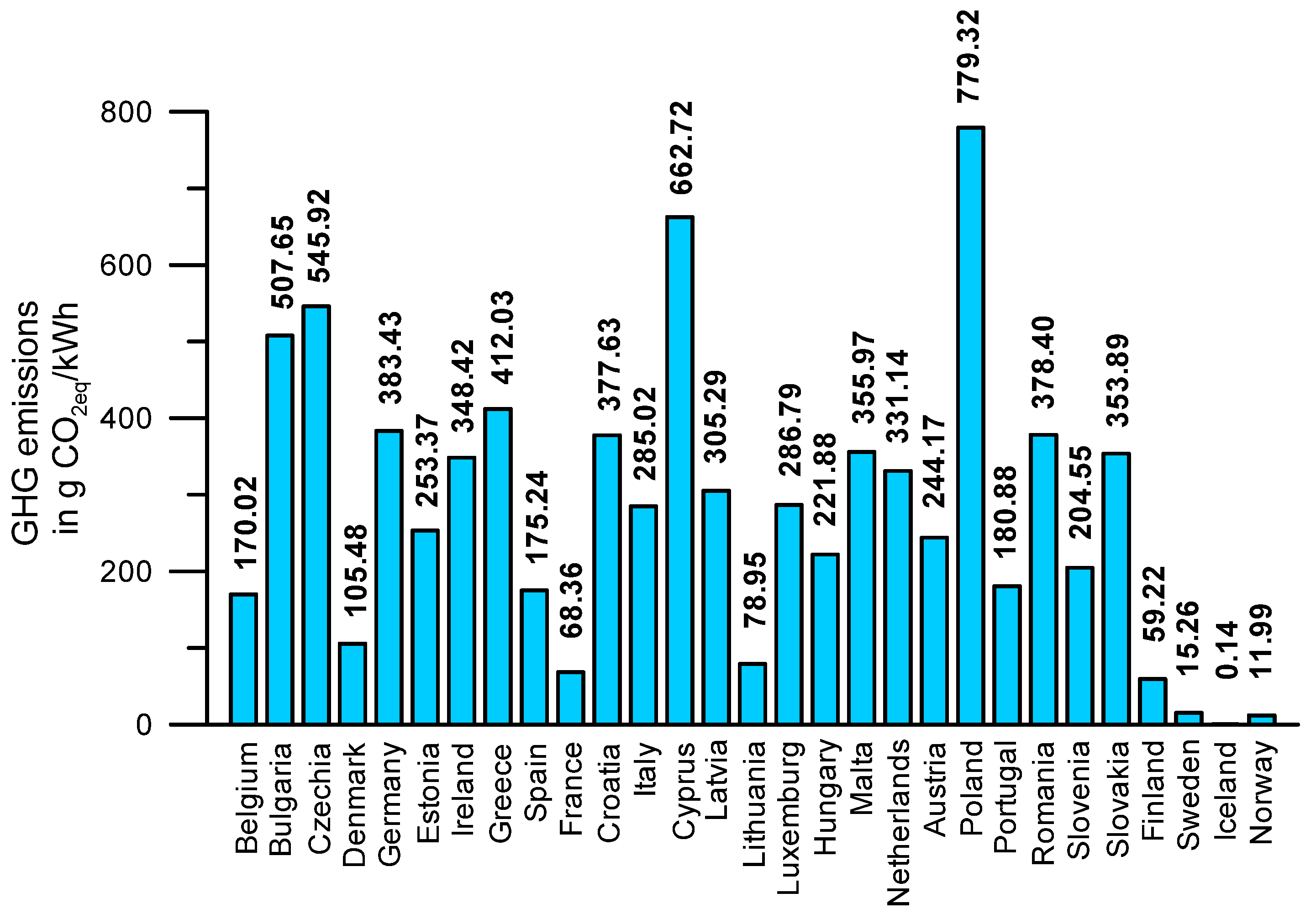

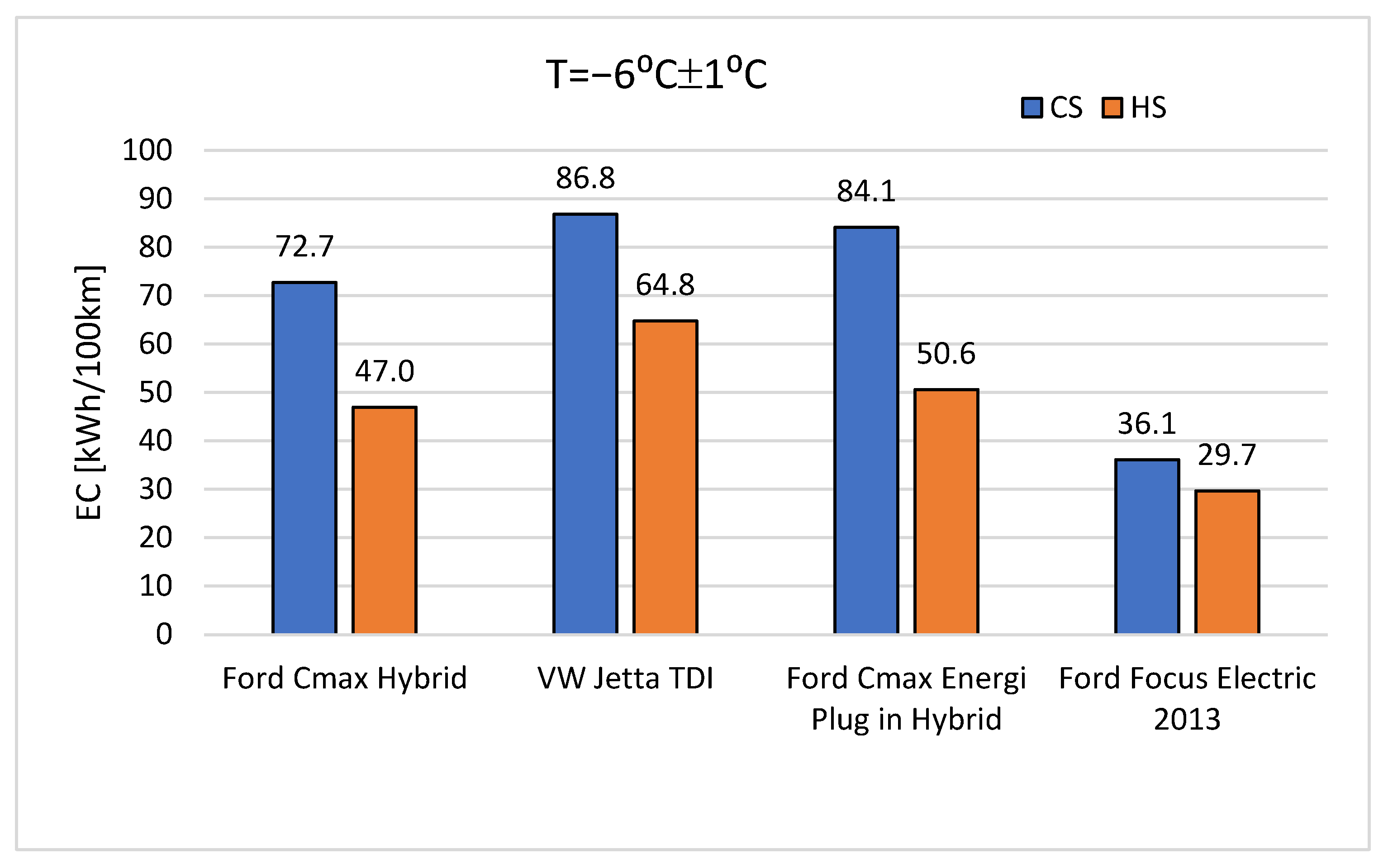


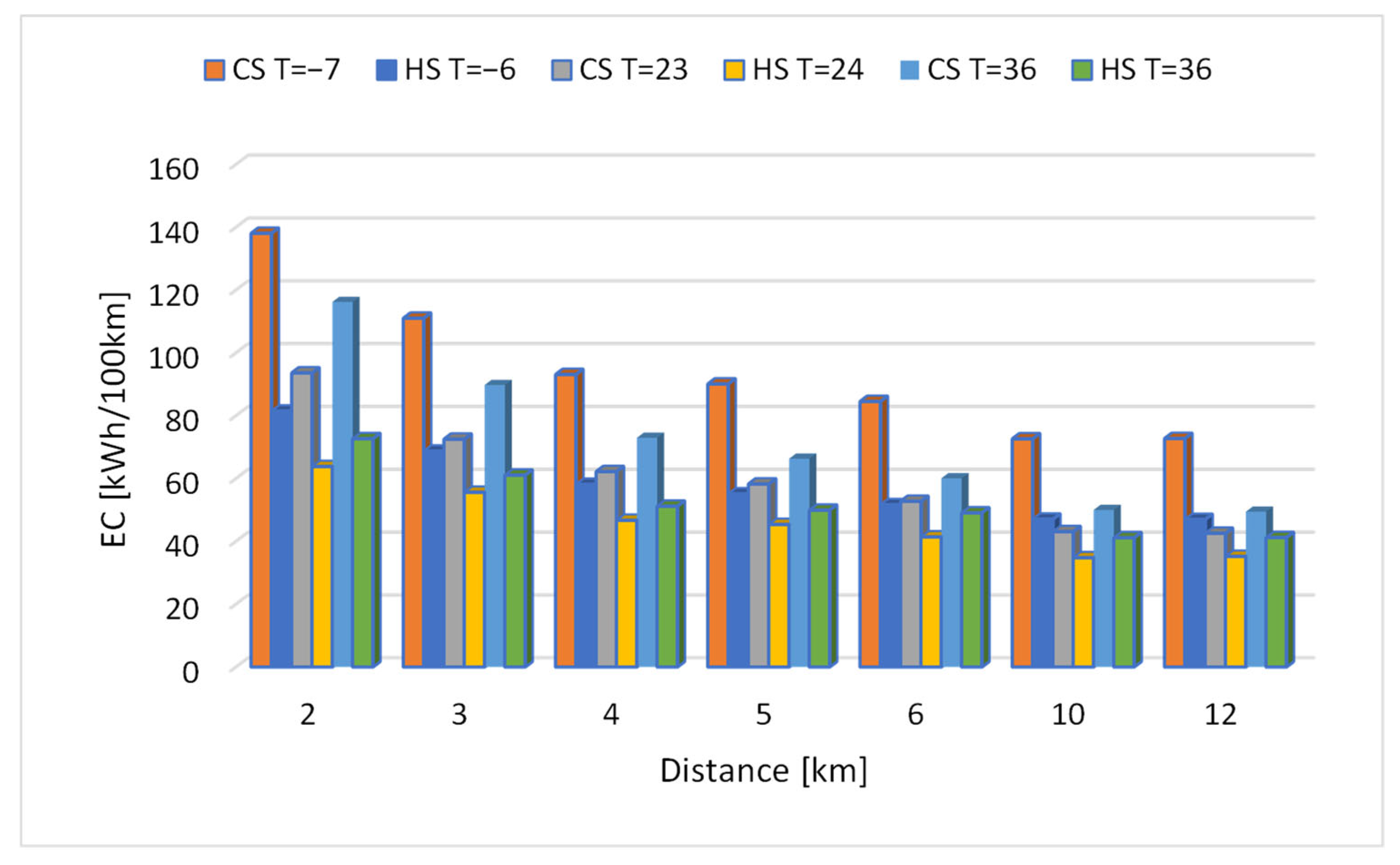


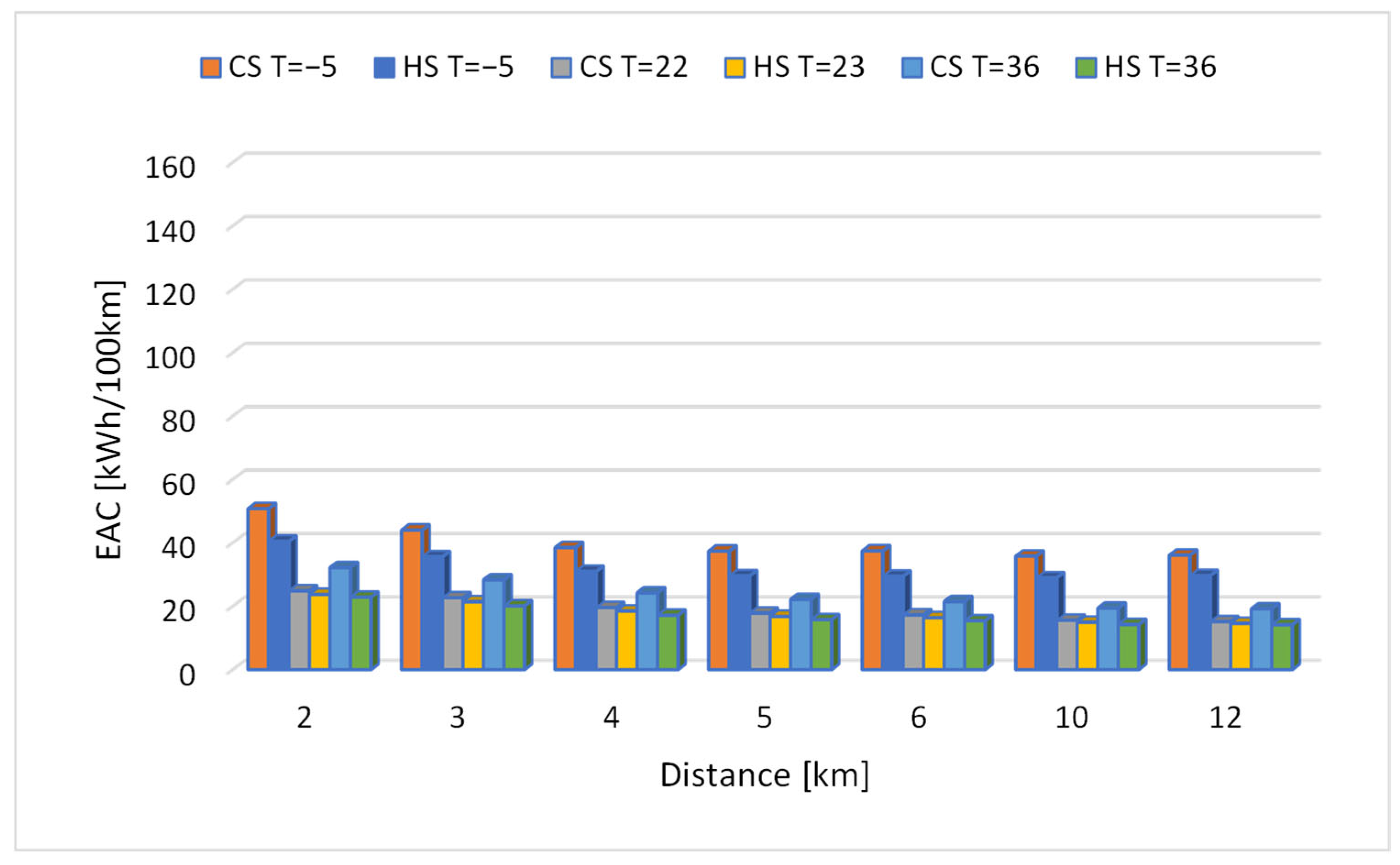

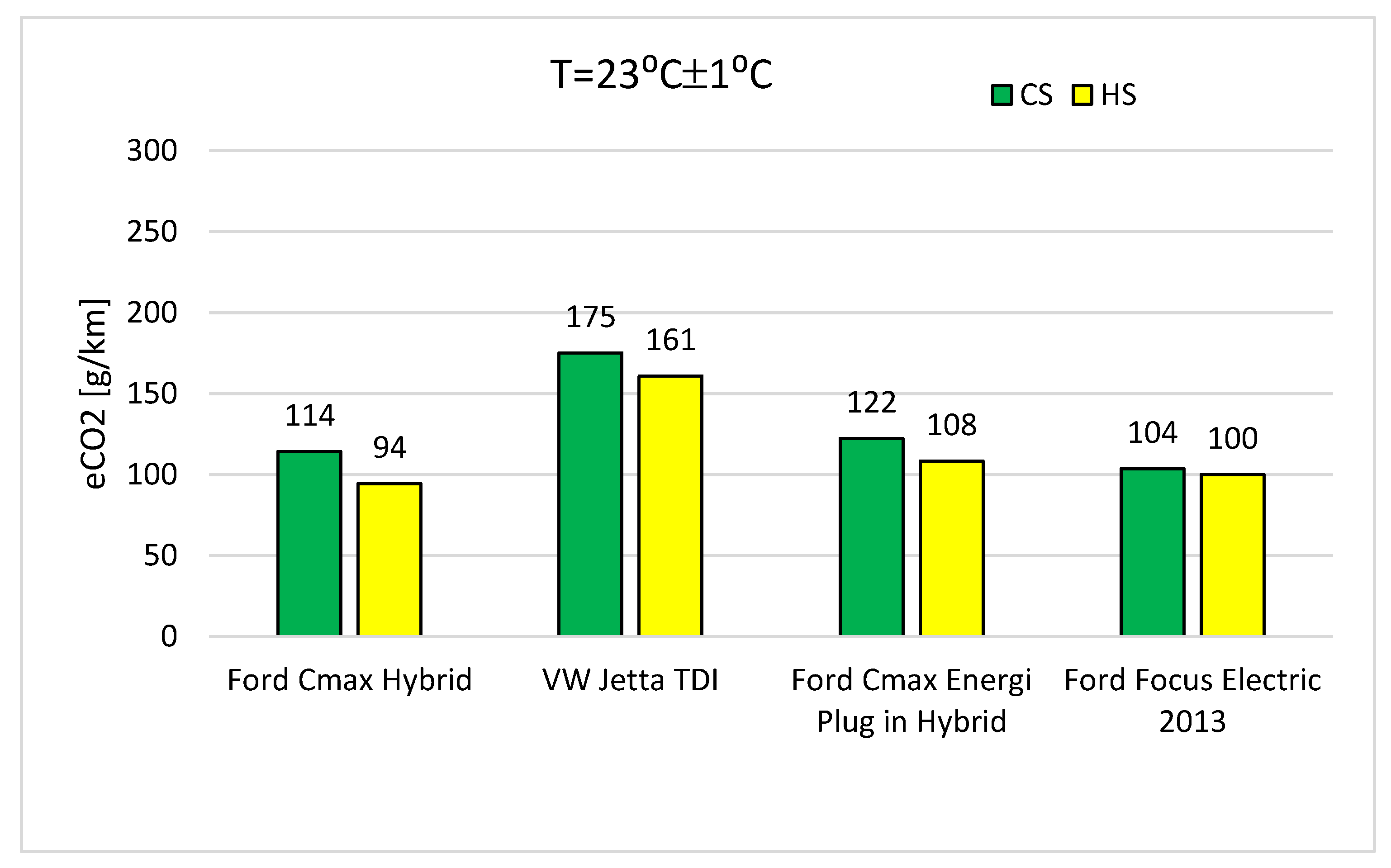
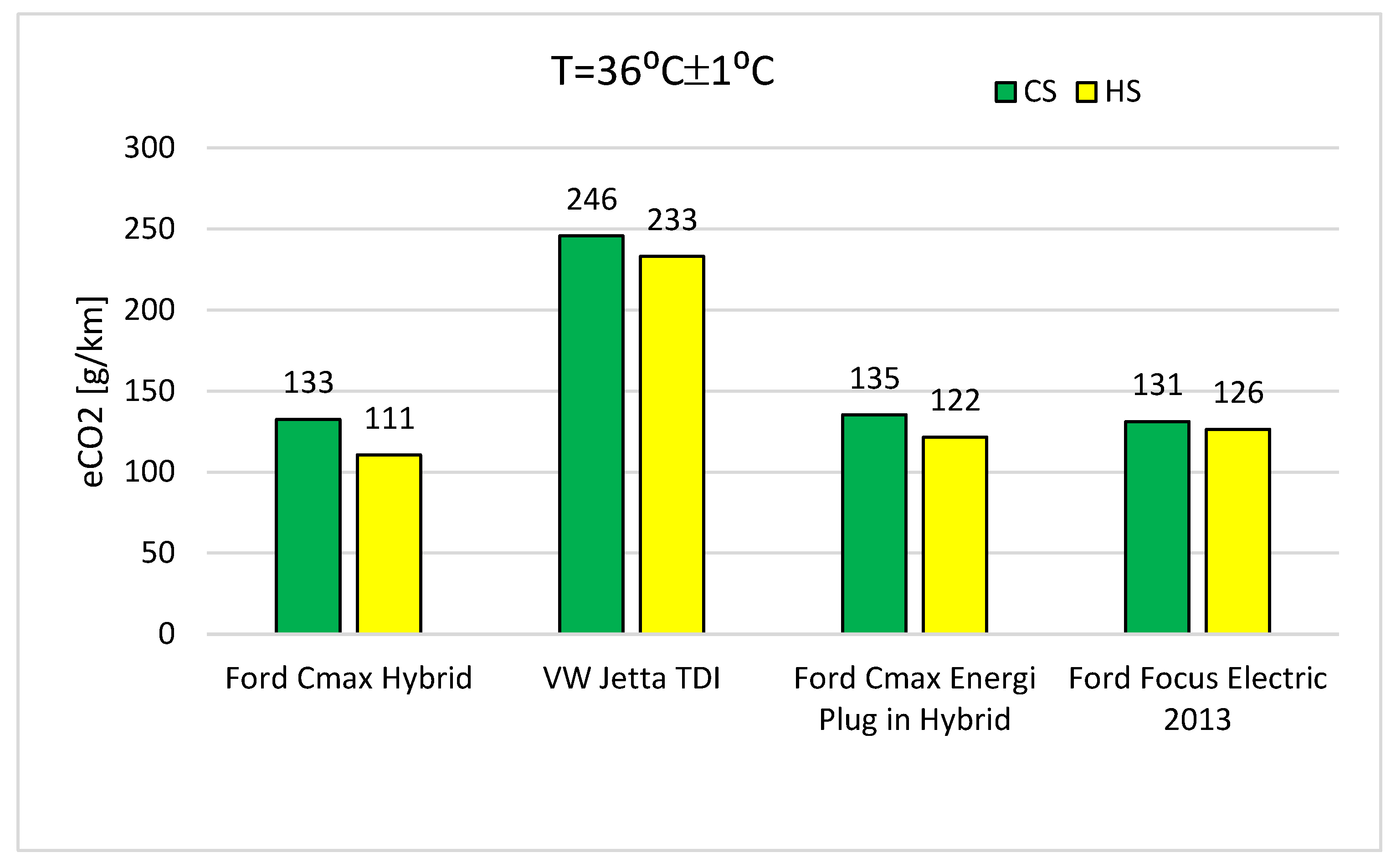



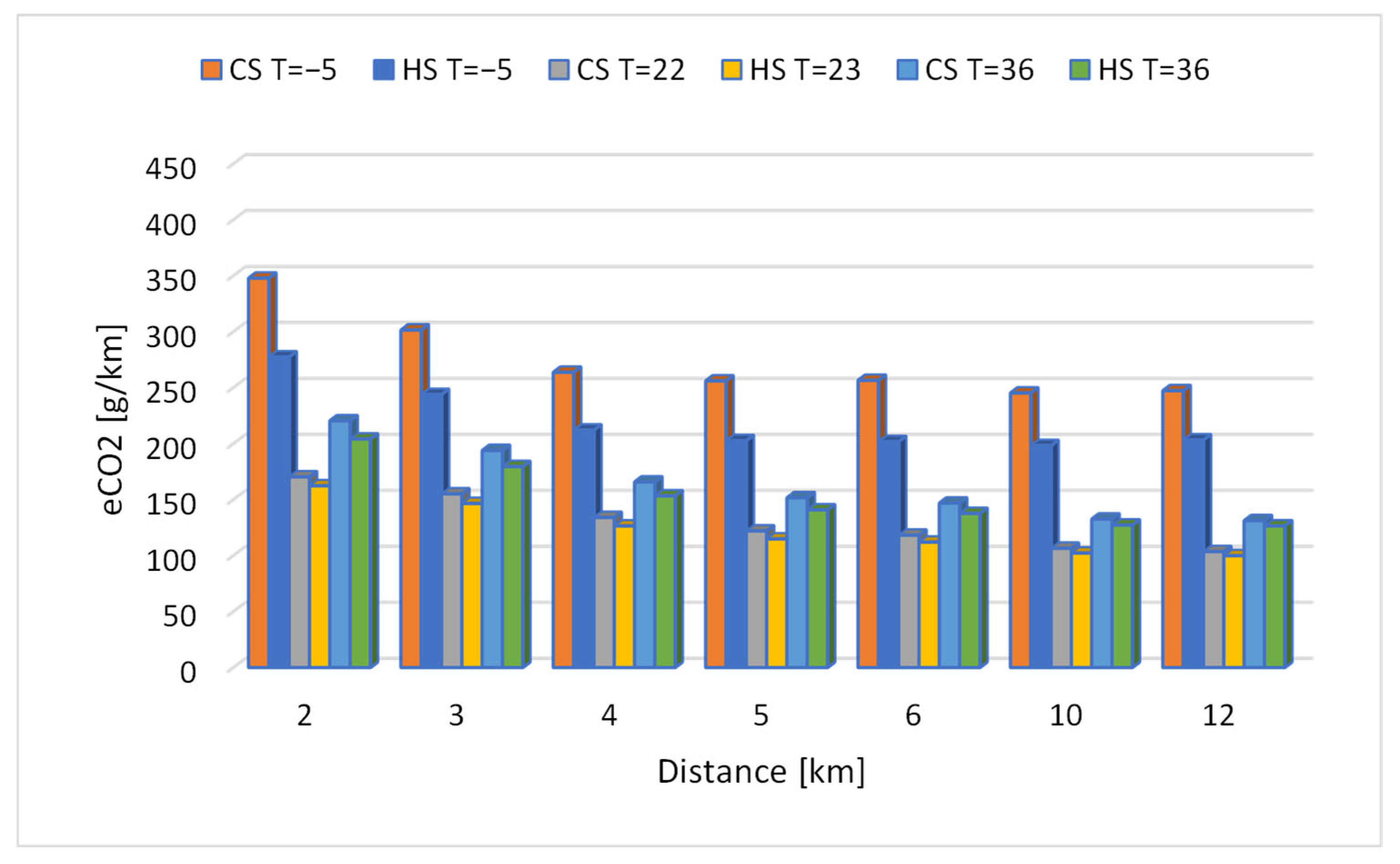

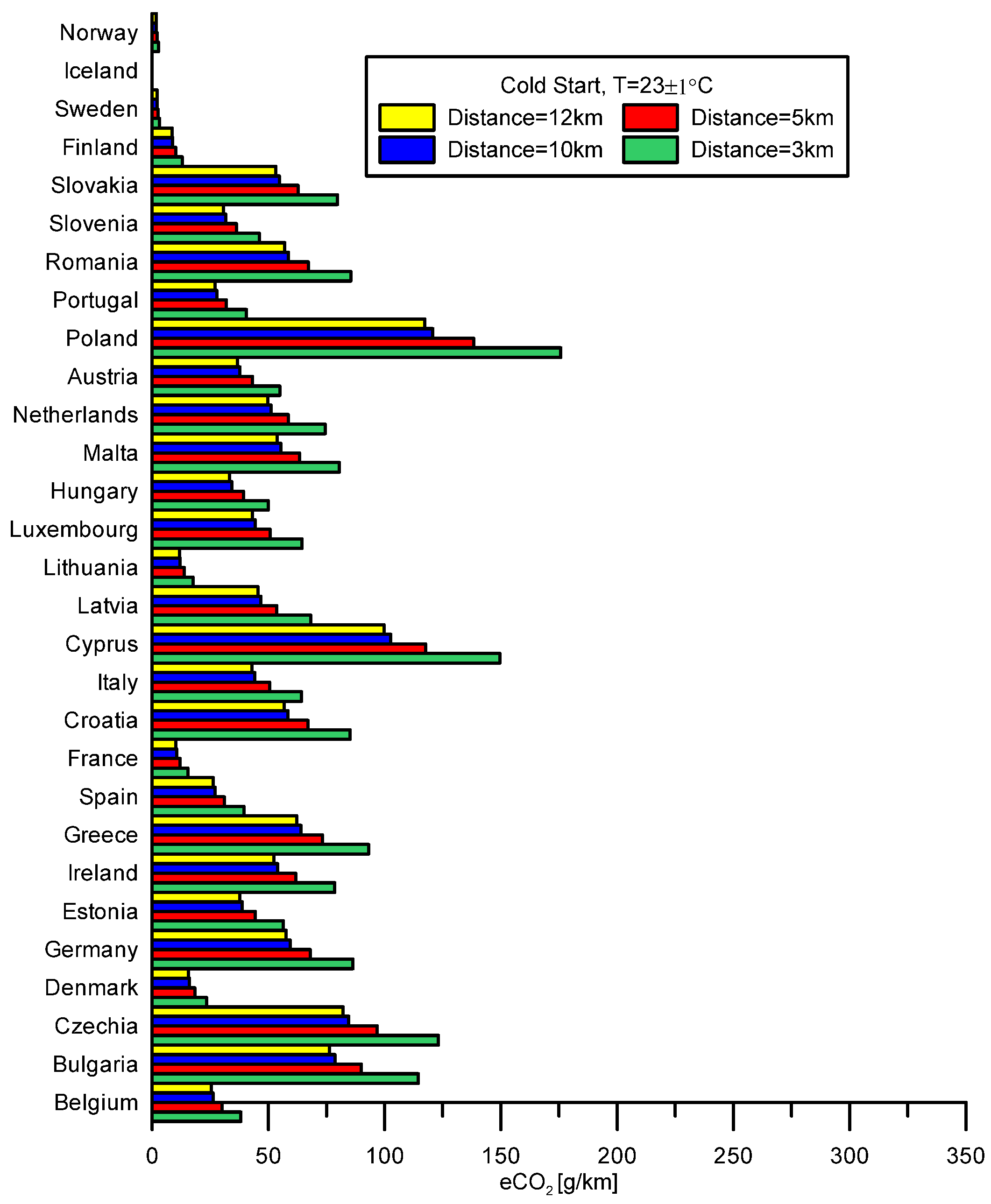



| Parameter | Ford Focus Electric 2013 | Ford Cmax Hybrid 2013 | Ford Cmax Energi 2013 | VW Jetta TDI 2013 |
|---|---|---|---|---|
| Vehicle type | Battery-Electric Vehicle | Hybrid/Petrol | Plug-in Hybrid/Petrol | Conventional/ Diesel |
| Test weight (kg) | 1791 | 1814 | 1908 | 1595 |
| Target A (N) | 162.087 | 96.781 | 143.192 | 134.139 |
| Target B (N/(km/h)) | 1.4364 | 1.0094 | 1.3037 | 1.0412 |
| Target C (N/(km/h)2) | 0.02603 | 0.03195 | 0.02884 | 0.02692 |
| Fuel type | electricity | petrol/electricity | petrol/electricity | diesel |
| Fuel density (kg/dm3) | - | 0.741 | 0.740 | 0.855 |
| Fuel Net HV (MJ/kg) | - | 42.703 | 43.015 | 42.694 |
| Parameter | Ford Focus Electric 2013 | Ford Cmax Hybrid 2013 | Ford Cmax Energi 2013 | VW Jetta TDI 2013 |
|---|---|---|---|---|
| Cold start engine oil temperature (°C) for the test at −6 ± 1 °C | - | –6.3 | –6.5 | –6.3 |
| Hot start engine oil temperature (°C) for the test at −6 ± 1 °C | - | 52.2 | 55.3 | 74.5 |
| Cold start engine oil temperature (°C) for the test at 23 ± 1 °C | - | 25.5 | 25.0 | 22.4 |
| Hot start engine oil temperature (°C) for the test at 23 ± 1 °C | - | 62.5 | 60.1 | 89.5 |
| Cold start engine oil temperature (°C) for the test at 36 ± 1 °C | - | 24.0 | 26.5 | 26.5 |
| Hot start engine oil temperature (°C) for the test at 36 ± 1 °C | - | 64.8 | 65.1 | 96.3 |
| SOC at the beginning/end of the CS test at −6 ± 1 °C (%) | 88.9/67.1 | 54.2/64.4 | 15.6/19.0 | - |
| SOC at the beginning/end of the HS test at −6 ± 1 (%) | 50.8/39.5 | 64.4/60.9 | 19.0/16.1 | - |
| SOC at the beginning/end of the CS test at 23 ± 1 °C (%) | 90.0/79.5 | 47.8/45.3 | 17.0/17.0 | - |
| SOC at the beginning/end of the HS test at 23 ± 1 (%) | 69.0/63.7 | 45.2/44.3 | 17.0/18.1 | - |
| SOC at the beginning/end of the CS test at 36 ± 1 °C (%) | 89.8/77.5 | 44.7/43.0 | 16.7/16.6 | - |
| SOC at the beginning/end of the HS test at 36 ± 1 °C (%) | 66.9/61.0 | 42.8/43.2 | 16.5/16.6 | - |
| Source of Variation | SS | df | MS | F | p-Value | F-Test |
|---|---|---|---|---|---|---|
| VW Jetta TDI 2013 | ||||||
| Thermal state (CS/HS) | 2415.6 | 1 | 2415.6 | 11.758 | 0.001417 | 4.084 |
| Ambient Temperature | 4261.2 | 2 | 2130.6 | 13.041 | 0.000046 | 3.238 |
| Ford Cmax Energi 2013 | ||||||
| Thermal state (CS/HS) | 7594.9 | 1 | 7594.9 | 15.1456 | 0.000368 | 4.084 |
| Ambient Temperature | 5251.5 | 2 | 2625.7 | 4.5713 | 0.016461 | 3.238 |
| Ford Cmax Hybrid 2013 | ||||||
| Thermal state (CS/HS) | 5800.5 | 1 | 5800.5 | 438.817 | 0.000424 | 4.084 |
| Ambient Temperature | 3809.2 | 2 | 1904.6 | 4.1989 | 0.022308 | 3.259 |
| Ford Focus Electric 2013 | ||||||
| Thermal state (CS/HS) | 125.42 | 1 | 125.42 | 1.6087 | 0.212001 | 4.084 |
| Ambient Temperature | 2323.4 | 2 | 1161.7 | 49.223 | 21.48 × 10−12 | 3.238 |
Disclaimer/Publisher’s Note: The statements, opinions and data contained in all publications are solely those of the individual author(s) and contributor(s) and not of MDPI and/or the editor(s). MDPI and/or the editor(s) disclaim responsibility for any injury to people or property resulting from any ideas, methods, instructions or products referred to in the content. |
© 2025 by the authors. Licensee MDPI, Basel, Switzerland. This article is an open access article distributed under the terms and conditions of the Creative Commons Attribution (CC BY) license (https://creativecommons.org/licenses/by/4.0/).
Share and Cite
Jaworski, A.; Kuszewski, H.; Balawender, K. Cold-Start Energy Consumption and CO2 Emissions—A Comparative Assessment of Various Powertrains in the Context of Short-Distance Trips. Energies 2025, 18, 6114. https://doi.org/10.3390/en18236114
Jaworski A, Kuszewski H, Balawender K. Cold-Start Energy Consumption and CO2 Emissions—A Comparative Assessment of Various Powertrains in the Context of Short-Distance Trips. Energies. 2025; 18(23):6114. https://doi.org/10.3390/en18236114
Chicago/Turabian StyleJaworski, Artur, Hubert Kuszewski, and Krzysztof Balawender. 2025. "Cold-Start Energy Consumption and CO2 Emissions—A Comparative Assessment of Various Powertrains in the Context of Short-Distance Trips" Energies 18, no. 23: 6114. https://doi.org/10.3390/en18236114
APA StyleJaworski, A., Kuszewski, H., & Balawender, K. (2025). Cold-Start Energy Consumption and CO2 Emissions—A Comparative Assessment of Various Powertrains in the Context of Short-Distance Trips. Energies, 18(23), 6114. https://doi.org/10.3390/en18236114









